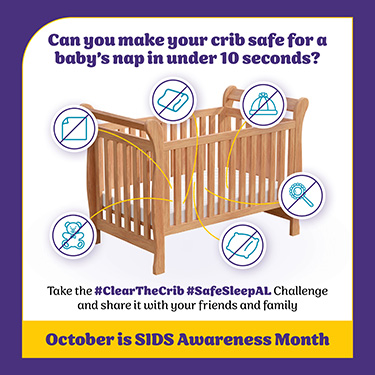- Perinatal Program Home
- News and Events
- Annual Progress Report
- Breastfeeding
- Alabama Maternal Mortality Review Program
- Alabama Fetal and Infant Mortality Review Program
- Infant Mortality
- Perinatal Partners
- Perinatal Regionalization
- Pregnancy Resources
- Preparing for Disaster
- Perinatal Regions and Coordinators
- Related Links
- RPAC Members
- Safe Sleep
- Cribs for Kids® - Alabama
- SPAC Members
- State of Alabama Infant Mortality Reduction Plan
- Contact Us
Safe Sleep
Sleep-related infant deaths are still a major problem in Alabama. In 2023, 449 babies tragically died before their first birthday. Of those deaths, 29 were officially ruled sleep-related with the cause of death listed as either “sudden infant death syndrome” (SIDS) or “accidental suffocation or strangulation in bed.” An additional 15 deaths were listed as “undetermined,” although many of those deaths occurred while the baby was sleeping.
Some of these deaths are preventable. There are risk factors that caregivers can control to lower their baby's risk of dying while sleeping.
#ClearTheCrib and #SafeSleepAL Challenge

To help highlight and clarify what a safe, clear crib environment looks like, the Alabama Department of Public Health (ADPH) is promoting the National Institute of Health’s Safe to Sleep® #ClearTheCrib Challenge. This social media challenge is a fun and engaging way to highlight the importance of a clear crib to reduce the risk of suffocation and other SUIDs. All pillows, loose blankets, bumper pads, stuffed animals, and even baby hats should be removed from a crib for a baby to sleep safely. To successfully “Clear the Crib,” participants need to remove all unsafe items from a cluttered crib and ensure that the doll representing the baby is safely positioned. This is a timed challenge.
October is SIDS Awareness Month. ADPH invites you to be creative and use your social media platforms during October to educate communities about safe sleep for infants. We have included a few of ours below. Make sure to include the tags #ClearTheCrib and #SafeSleepAL in your public posts so that we can see and share your posts.
Download the Challenge Instructions
Watch Clear the Crib Videos on our YouTube Channel
Alone
- We, along with the American Academy of Pediatrics (AAP), recommend that the baby should sleep in the same room as the parents, but not in the same bed (room-sharing without bed-sharing).
Back
- Unless otherwise instructed by a pediatrician, an infant should always sleep on its back, on a firm, flat surface.
- An infant sleeping on its side or stomach faces an increased risk of Sudden Unexplained Infant Death (SUID).
- Infants should sleep without the aid of wedges and cushions.
Crib
- Railings should be no more than 2 3/8 inches apart - tight enough that a soda can not fit through them.
- The mattress should be firm, flat, and covered with a tight, fitted sheet.
- Keep your baby's crib clutter-free - no blankets, pillows, bumper pads, stuffed animals, etc.
- Waterbeds, futons, recliners, and sofas are not acceptable substitutes for a crib.
Safe Sleep Posters
- Babies sleep safest when... English | Spanish
- Safe sleep is hard, but your baby is worth it. English | Spanish
Safe Sleep Videos
"What is Safe Sleep for Babies?" (from the Charlie's Kids Foundation)
"Room Share, Don't Bed Share" (from the Charlie's Kids Foundation)
Additional videos:
- Safe Sleep (Children's of Alabama/UAB Medicine)
- Safe Sleep for Your Baby (U.S. Department of Health and Human Services/National Institutes of Health)
- University of Alabama Coach Nick Saban on Creating a Safe Sleep Environment
Alabama Collaborative on Safe Sleep
The Collaborative has produced a Position Statement providing valuable information about safe sleep issues and providing contact information for resources. The Collaborative has also developed a Step-by-Step Blueprint for the use of providers who are working to make the sleep environments in their facilities safer for infants.
For more information on preventing infant sleep-related deaths, please view the following sites: CDC-Sudden Infant Death (SUID), Updated 2022 AAP Recommendations, the Consumer Product Safety Commission, and First Candle.
Page last updated: October 20, 2025




